Sustainable Development Goal 8
Promote sustained, inclusive and sustainable economic growth, full and productive employment and decent work for all
Sustainable Development Goal 8 is to “promote sustained, inclusive and sustainable economic growth, full and productive employment and decent work for all”, according to the United Nations.
The visualizations and data below present the global perspective on where the world stands today and how it has changed over time.
The UN has defined 12 targets and 16 indicators for SDG 8. Targets specify the goals and indicators represent the metrics by which the world aims to track whether these targets are achieved. Below we quote the original text of all targets and show the data on the agreed indicators.
List of targets and indicators
Target 8.1Sustainable Economic Growth
SDG Indicator 8.1.1GDP per capita growth rate
Definition of the SDG indicator: Indicator 8.1.1 is “annual growth rate of real GDP per capita” in the UN SDG framework.
This is measured as the annual percentage growth in gross domestic product (GDP) per capita based on constant United States dollars.
Data for this indicator is shown in the interactive visualization.
Target: “Sustain per capita economic growth in accordance with national circumstances and, in particular, at least 7 per cent gross domestic product growth per annum in the least developed countries”.
More research: Further data and research on this topic can be found at the Our World in Data topic page on economic growth.
Additional charts

Target 8.2Diversify, innovate and upgrade for economic productivity
SDG Indicator 8.2.1GDP per capita growth rate per employed person
Definition of the SDG indicator: Indicator 8.2.1 is “annual growth rate of real GDP per employed person” in the UN SDG framework.
This is measured as the annual change in real gross domestic product (GDP) per employed person. It provides an overall measure of the change in productivity of a country's labor force and use of resources.
Data for this indicator is shown in the interactive visualization.
Target: “Achieve higher levels of economic productivity through diversification, technological upgrading and innovation, including through a focus on high-value-added and labour-intensive sectors”.
More research: Further data and research on this topic can be found at the Our World in Data topic page on economic growth.
Additional charts
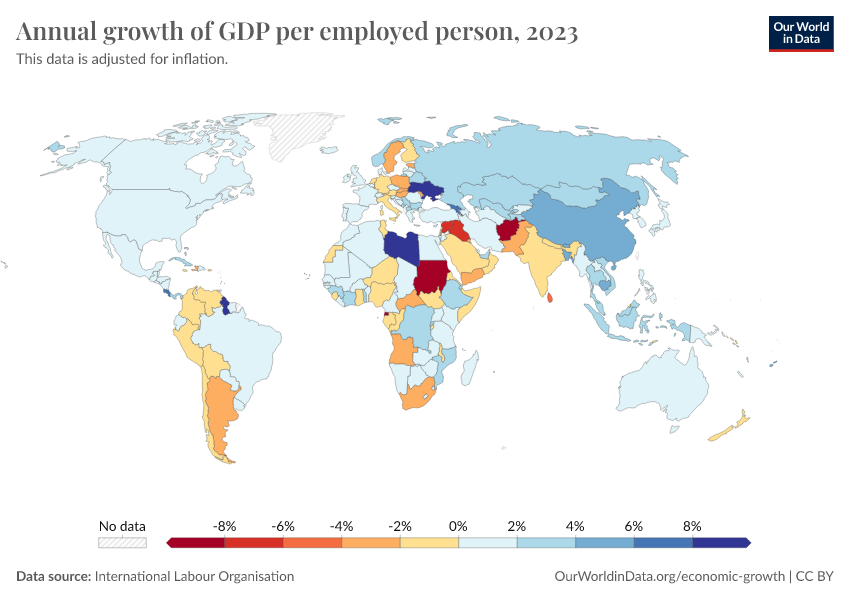
Target 8.3Promote policies to support job creation and growing enterprises
SDG Indicator 8.3.1Informal employment
Definition of the SDG indicator: Indicator 8.3.1 is the “proportion of informal employment in total employment, by sector and sex” in the UN SDG framework.
This is measured as employment in the informal economy as a percentage of total employment. This includes all jobs in unregistered and/or small-scale private unincorporated enterprises that produce goods or services meant for sale or barter.
In the interactive visualizations, we show the proportion of informal employment in total employment for all types of work, including agricultural work, along with these estimates by sex.
Target: “Promote development-oriented policies that support productive activities, decent job creation, entrepreneurship, creativity and innovation, and encourage the formalization and growth of micro-, small- and medium-sized enterprises, including through access to financial services”.
More research: Further data and research on this topic can be found at the Our World in Data topic page on women’s employment.
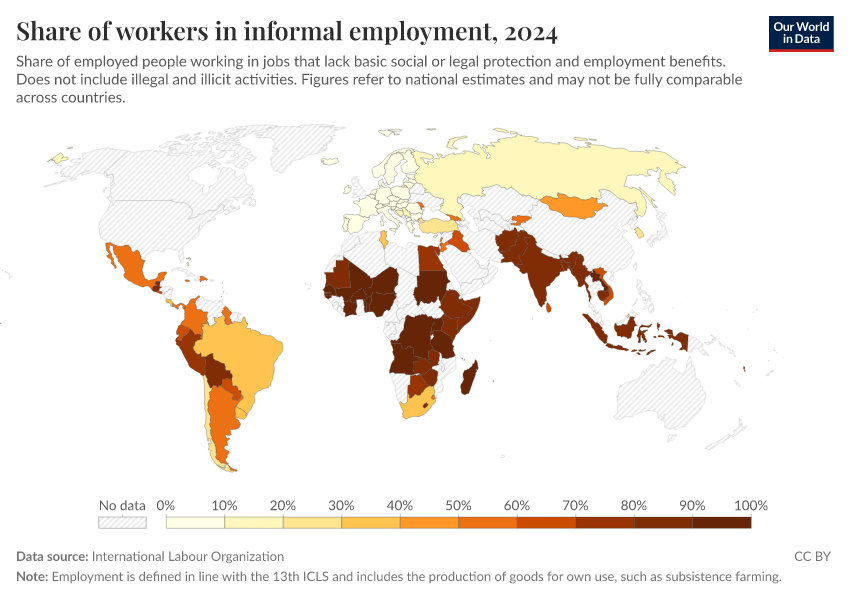
Target 8.4Improve resource efficiency in consumption and production
SDG Indicator 8.4.1Material footprint
Definition of the SDG indicator: Indicator 8.4.1 is “material footprint, material footprint per capita, and material footprint per GDP” in the UN SDG framework.
Material footprint is the attribution of global material extraction to domestic final demand of a country. The total material footprint is the sum of the weight of the used biomass, fossil fuels, metal ores and non-metal ores.
Data on this indicator for material footprint per capita and per unit of GDP is shown in the interactive visualizations.
Target: “Improve progressively, through 2030, global resource efficiency in consumption and production and endeavour to decouple economic growth from environmental degradation.”1

SDG Indicator 8.4.2Domestic material consumption
Definition of the SDG indicator: Indicator 8.4.2 is “domestic material consumption, domestic material consumption per capita, and domestic material consumption per GDP” in the UN SDG framework.
Domestic Material Consumption (DMC) measures the total amount of material directly used in an economy. It is a production-side measure which does not capture the amount needed for within-country demand. This means that a country with high levels of production for export could have a high DMC, while a country that outsources most of its material intensive industrial processes to other countries would have a low DMC.
Data on this indicator for domestic material consumption per capita and per unit of GDP is shown in the interactive visualizations.
Target: “Improve progressively, through 2030, global resource efficiency in consumption and production and endeavour to decouple economic growth from environmental degradation.”1

Target 8.5Full employment and decent work with equal pay
SDG Indicator 8.5.1Hourly earnings
Definition of the SDG indicator: Indicator 8.5.1 is the “average hourly earnings of employees, by sex, age, occupation and persons with disabilities” in the UN SDG framework.
Although the UN defines this indicator in terms of current local currency, we report this data expressed in international-$ at 2011 prices. It is adjusted for inflation and differences in the cost of living between countries.
Data for this indicator is shown in the interactive visualisations. The first chart shows average hourly earnings for all employees, and the second chart shows average hourly earnings for male and female employees separately.
Target: “By 2030, achieve full and productive employment and decent work for all women and men, including for young people and persons with disabilities, and equal pay for work of equal value.”
More research: Further data and research on this topic can be found at the Our World in Data topic pages on women’s employment, working hours and our article on “Six key facts about the gender pay gap”.
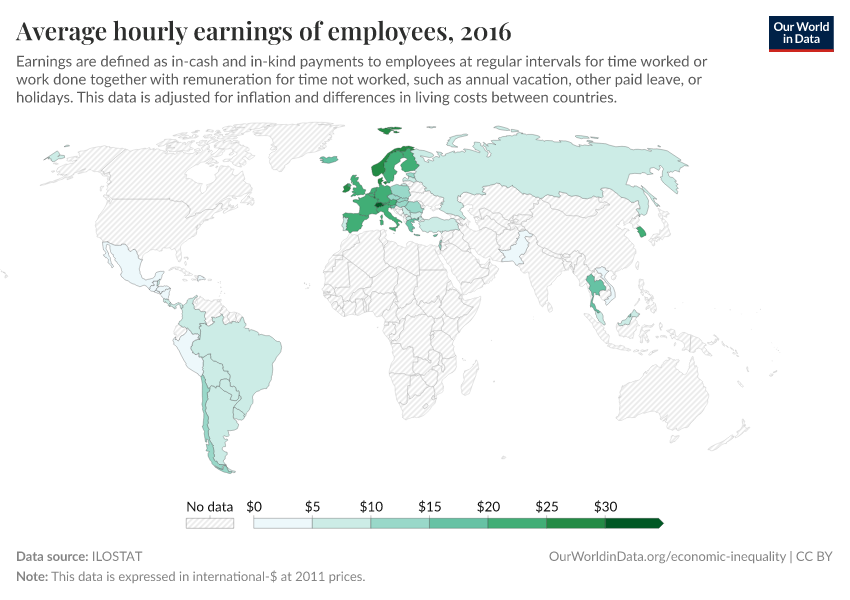
SDG Indicator 8.5.2Unemployment rate
Definition of the SDG indicator: Indicator 8.5.2 is the “unemployment rate, by sex, age and persons with disabilities”, in the UN SDG framework.
Unemployment rate is measured as the share of the labor force that is without work but available for and seeking employment.
Data for this indicator is shown in the interactive visualizations for the overall population, by sex, and by disability status.
Target: “By 2030, achieve full and productive employment and decent work for all women and men, including for young people and persons with disabilities, and equal pay for work of equal value.”

Target 8.6Promote youth employment, education and training
SDG Indicator 8.6.1Youth employment, education and training
Definition of the SDG indicator: Indicator 8.6.1 is the “proportion of youth (aged 15–24 years) not in education, employment or training” in the UN SDG framework.
This is measured as the share of young people (aged 15-24 years) not in education, employment or training in a given country and year.
Data for this indicator is shown in the interactive visualization.
Target: “By 2020, substantially reduce the proportion of youth not in employment, education or training.”
More research: Further data and research on this topic can be found at the Our World in Data topic page on tertiary education.
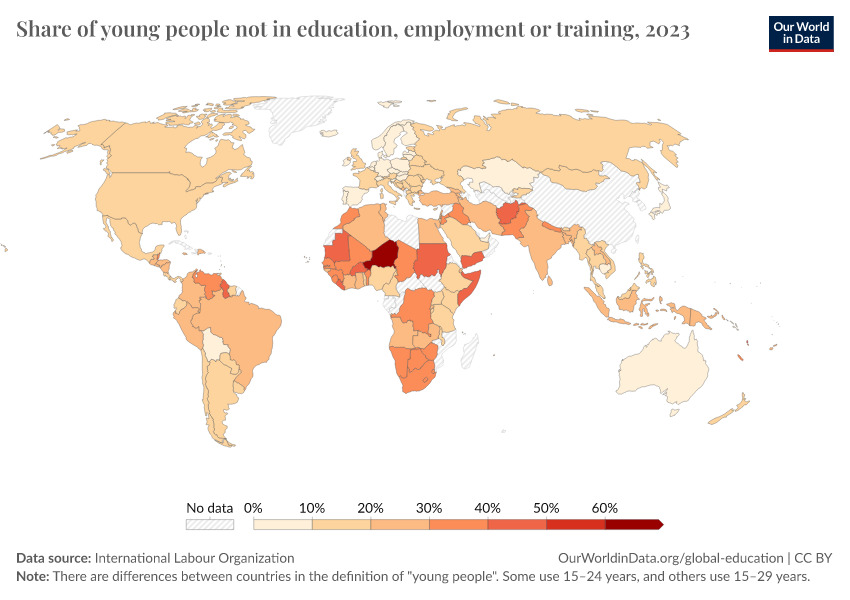
Target 8.7End modern slavery, trafficking, and child labor
SDG Indicator 8.7.1Child labor
Definition of the SDG indicator: Indicator 8.7.1 is the “proportion and number of children aged 5–17 years engaged in child labour, by sex and age” in the UN SDG framework.
This indicator is measured as the share of children aged 5-17 years old in employment, defined as being engaged in economic activities at or above age-specific hourly thresholds (1 hour or more per week for children aged 5-11, 14 hours or more for children aged 12-14, and 43 hours or more for children aged 15-17).
Data for this indicator is shown in the interactive visualizations, with the first chart showing the measure for all children aged 5-17 and the second chart showing this measure by sex.
Target: “Take immediate and effective measures to eradicate forced labour, end modern slavery and human trafficking and secure the prohibition and elimination of the worst forms of child labour, including recruitment and use of child soldiers, and by 2025 end child labour in all its forms.”
More research: Further data and research on this topic can be found at the Our World in Data topic page on child labor.
Additional charts
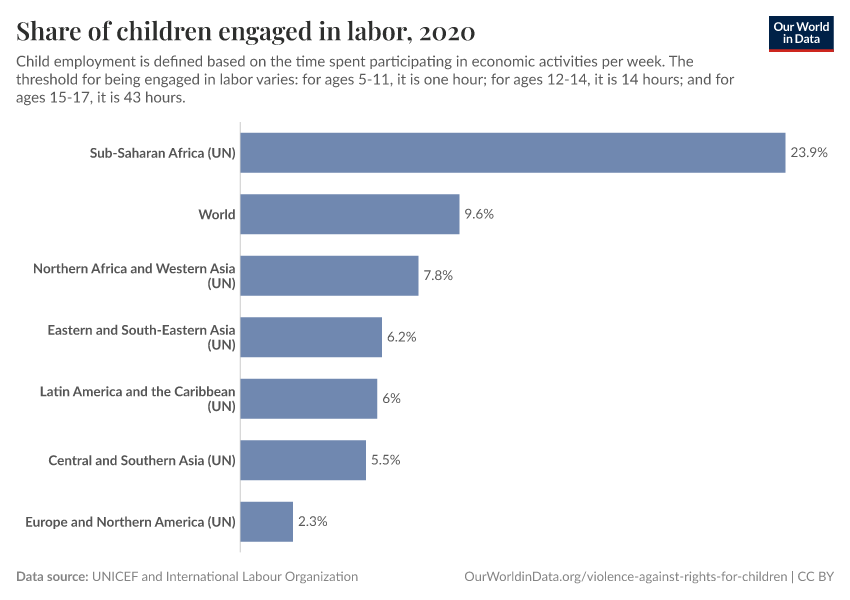
Target 8.8Protect labor rights and promote safe working environments
SDG Indicator 8.8.1Occupational injuries
Definition of the SDG indicator: Indicator 8.8.1 is “fatal and non-fatal occupational injuries per 100,000 workers, by sex and migrant status” in the UN SDG framework.
This indicator measures the rates of fatal and non-fatal occupational injuries by country, in terms of the number of injuries per 100,000 employees. An injury in this context refers to any personal injury, disease, or death resulting from an occupational accident; it does not, therefore, include occupational disease, which is the result of exposure over a period of time to risk factors related to the work activity.
Data for this indicator is shown in the interactive visualizations.
Target: “Protect labour rights and promote safe and secure working environments for all workers, including migrant workers, in particular women migrants, and those in precarious employment.”

SDG Indicator 8.8.2Compliance of labor rights
Definition of the SDG indicator: Indicator 8.8.2 is the “level of national compliance with labour rights (freedom of association and collective bargaining) based on International Labour Organization (ILO) textual sources and national legislation, by sex and migrant status” in the UN SDG framework.
This indicator is measured by coding against a set of evaluation criteria textual sources from International Labour Organization (ILO) reports and national legislation. Values of the indicator range from 0 to 10, with 10 representing the lowest (worst) level of compliance.
Data for this indicator is shown in the interactive visualization.
Target: “Protect labour rights and promote safe and secure working environments for all workers, including migrant workers, in particular women migrants, and those in precarious employment.”

Target 8.9Promote beneficial and sustainable tourism
SDG Indicator 8.9.1Tourism contribution to GDP
Definition of the SDG indicator: Indicator 8.9.1 is “tourism direct GDP as a proportion of total GDP and in growth rate” in the UN SDG framework.
This indicator measures the proportion of total gross domestic product that is generated by all industries in response to tourism, including internal tourism consumption and net taxes on products and imports included in the value of this expenditure. It measures the economic contribution of tourism to a country’s GDP.
The interactive visualization shows data for this indicator on tourism direct GDP as a proportion of total GDP; data on its growth rate is currently not available.
Target: “By 2030, devise and implement policies to promote sustainable tourism that creates jobs and promotes local culture and products.”
More research: Further data and research on this topic can be found at the Our World in Data topic page on tourism.
Additional charts
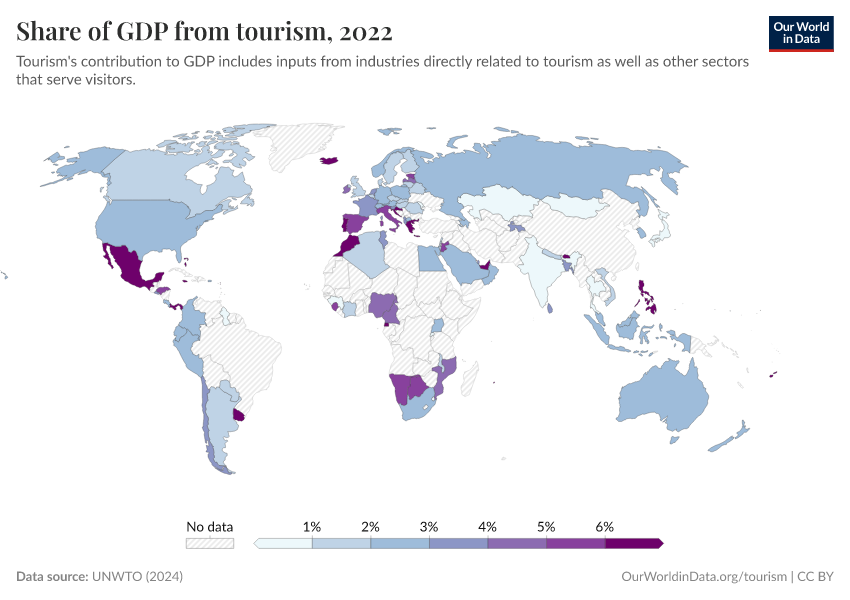
Target 8.10Universal access to banking, insurance and financial services
SDG Indicator 8.10.1Access to financial services
Definition of the SDG indicator: Indicator 8.10.1 is the “(a) number of commercial bank branches per 100,000 adults and (b) number of automated teller machines (ATMs) per 100,000 adults” in the UN SDG framework.
This is measured as the number of commercial bank branches and ATMs per 100,000 adults (individuals aged above 15 in this context).
Data for this indicator is shown in the interactive visualizations, with data on commercial bank branches in the first chart and data on ATMs in the second chart.
Target: “Strengthen the capacity of domestic financial institutions to encourage and expand access to banking, insurance and financial services for all.”

SDG Indicator 8.10.2Population with financial account
Definition of the SDG indicator: Indicator 8.10.2 is the “proportion of adults (15 years and older) with an account at a bank or other financial institution or with a mobile-money-service provider” in the UN SDG framework.
This indicator is measured as the percentage of adults (aged 15 and older) who report having an account (by themselves or together with someone else) at a bank or another type of financial institution, or report personally using a mobile money service in the past 12 months.
Data for this indicator is shown in the interactive visualization.
Target: “Strengthen the capacity of domestic financial institutions to encourage and expand access to banking, insurance and financial services for all.”
Additional charts
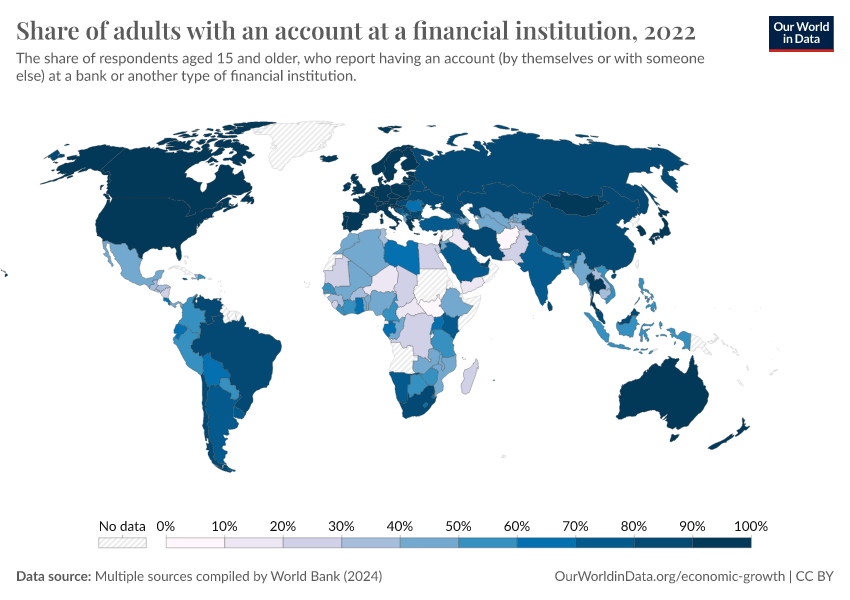
Target 8.aIncrease aid for trade support
SDG Indicator 8.a.1Aid for Trade
Definition of the SDG indicator: Indicator 8.a.1 is “aid for trade commitments and disbursements” in the UN SDG framework.
Aid for trade is measured as total official development assistance allocated to aid for trade in millions of constant 2020 United States dollars.
Official development assistance refers to flows to countries and territories on the OECD’s Development Assistance Committee (DAC) and to multilateral institutions which meet a set of criteria related to the source of the funding, the purpose of the transaction, and the concessional nature of the funding.
Data for this indicator is reported in the interactive visualizations by recipient (first chart) and donor country (second chart).
Target: “Increase aid for trade support for developing countries, in particular least developed countries, including through the Enhanced Integrated Framework for Trade-related Technical Assistance to Least Developed Countries”.
More research: Further data and research on this topic can be found at the Our World in Data topic page on trade and globalization.

Target 8.bDevelop a global youth employment strategy
SDG Indicator 8.b.1Youth employment strategy
Definition of the SDG indicator: Indicator 8.b.1 is the “existence of a developed and operationalized national strategy for youth employment, as a distinct strategy or as part of a national employment strategy” in the UN SDG framework.
This indicator is based on a classification system developed by the International Labour Organization to measure the extent to which a country has a developed and operationalized national strategy for youth employment.
Data for this indicator is shown in the interactive visualization.
Target: “By 2020, develop and operationalize a global strategy for youth employment and implement the Global Jobs Pact of the International Labour Organization”.

Endnotes
Full text: “Improve progressively, through 2030, global resource efficiency in consumption and production and endeavour to decouple economic growth from environmental degradation, in accordance with the 10-Year Framework of Programmes on Sustainable Consumption and Production, with developed countries taking the lead.”
Cite this work
Our articles and data visualizations rely on work from many different people and organizations. When citing this article, please also cite the underlying data sources. This article can be cited as:
Our World in Data team (2023) - “Promote sustained, inclusive and sustainable economic growth, full and productive employment and decent work for all” Published online at OurWorldinData.org. Retrieved from: 'https://archive.ourworldindata.org/20251220-152415/sdgs/economic-growth.html' [Online Resource] (archived on December 20, 2025).BibTeX citation
@article{owid-sdgs-economic-growth,
author = {Our World in Data team},
title = {Promote sustained, inclusive and sustainable economic growth, full and productive employment and decent work for all},
journal = {Our World in Data},
year = {2023},
note = {https://archive.ourworldindata.org/20251220-152415/sdgs/economic-growth.html}
}Reuse this work freely
All visualizations, data, and code produced by Our World in Data are completely open access under the Creative Commons BY license. You have the permission to use, distribute, and reproduce these in any medium, provided the source and authors are credited.
The data produced by third parties and made available by Our World in Data is subject to the license terms from the original third-party authors. We will always indicate the original source of the data in our documentation, so you should always check the license of any such third-party data before use and redistribution.
All of our charts can be embedded in any site.